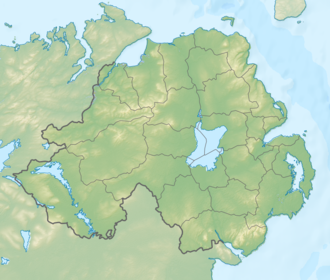| Slemish | |
|---|---|
 | |
| Highest point | |
| Elevation | 437 m (1,434 ft) |
| Prominence | 150 m (490 ft) |
| Listing | Marilyn |
| Coordinates | 54°52′55″N6°5′49″W / 54.88194°N 6.09694°W |
| Naming | |
| Native name | Sliabh Mis |
| English translation | Mis' Mountain |
| Geography | |
| Location | County Antrim, Northern Ireland |
| Parent range | Antrim Hills |
| OSI/OSNI grid | D221054 |
| Geology | |
| Mountain type | Volcanic plug |
Slemish, historically called Slieve Mish [1] (from Irish Sliabh Mis, meaning 'Mis's mountain'), [2] is a hill in County Antrim, Northern Ireland. It lies a few miles east of Ballymena, in the townland of Carnstroan. Tradition holds that Saint Patrick, enslaved as a youth, was brought to this area and tended sheep herds on Slemish, and that during this time he found God. [3]
Contents
Slemish is the remains of the plug of an extinct volcano. The plug is made of olivine dolerite [4] and was formed during the Palaeogene period of the Earth's geological history. [5] Its distinctive appearance —its upper reaches are very steep and rugged, in contrast to the tidy fields on its lower westward-facing slopes and the relatively flat bogland to the east— causes it to dominate the landscape for miles around.
Slemish is within an Environmentally Sensitive Area (ESA) and, therefore, helps to protect and manage the fragile animal and plant communities that inhabit its slopes. An ideal location for bird watchers, large black ravens, buzzards, wheatears and meadow pipits can be seen regularly.








